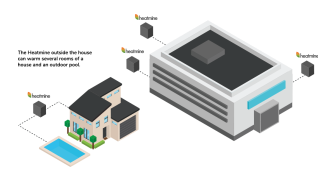Cryptocurrency is Heating Up, Literally: Offsetting Building Heat Needs with Cryptomining
In just a few years, the interconnected relationship between renewable energy and cryptocurrency have become a trendy topic on which to prognosticate, debate, and overreact. Depending on who you ask, cryptocurrency might be catastrophic for its massive energy requirements or be uniquely positioned to revolutionize the utility industry.
The cryptocurrency movement is still young and the degree to which it will become integral to the world economy, and thus its required energy needs, is still conjectural at best. But unquestionably, the energy-intensity of cryptocurrency mining and the general blockchain processes are important ones to examine as they could result in the trend sinking or swimming. Amid all this debate and speculation, the outside-the-box thinkers are instead asking how that crypto-energy can best be captured and utilized. If the computing power needs can serve dual purpose, then the mining process doesn’t needed to be considered benefit or bust purely on the cryptocurrency outcomes alone.
That’s where the Quebec-based startup Heatmine comes in. This company places its cryptocurrency miners— the computers used to generate Bitcoin and other digital currencies– in strategic locations for its clients so the buildings can benefit from the heat that comes off of them during the mining process. With miners that are capable of heating 300 square meters for 24 hours per day, what was once considered waste heat from the cryptomining process (even worse, heat that required additional air conditioning to cool down the space) has cleverly been turned into an asset to supplement heating needs, minimize power requirements, and effectively maximize cryptomining profits while minimizing its footprint on the energy grid.
I had the opportunity to learn more about this ingenious solution from Heatmine COO Jeremy Dahan.
In the Beginning
The idea behind Heatmine came to its inventors when Dahan and his partners realized that massive energy was being poured into cryptocurrency mining and such processing power naturally heated up the areas storing the computers. Thinking about this idea led to them to ask themselves “Can something be done with this waste heat?”
They approached that question in the classic brainstorming strategy of “no idea is dumb,” bringing out such outlandish suggestions as drying clothes or even heating oil to make french fries. The team eventually stumbled upon the idea of heating warehouses and greenhouses, and this thought was the one that really stuck.
In the six years since then, Heatmine has been completely self-financed and has spent much time and money to test, fine tune, and rework their combination mining/heating units to perfection. When asked about the challenges to this point, the COO indicated that the only real difficulty they’ve had thus far has been designing and fitting the water cooling loop onto the units in a manner that was reliably leak-free (water + computer processors = not the kind of cryptocurrency boom you want to see).
Source: Heatmine
How It Works
The key to Heatmine’s successful implementation has been the realization that releasing ambient heat to its surrounding room or building wasn’t efficient enough, and instead the mining units could complement a building’s larger heating system. After developing prototypes and much testing, Heatmine units plug directly into existing heating systems using a hot water system. The heat generated by a Heatmine unit is used to heat up water that feeds into a building’s radiators, boilers, or water heaters.
Each mining unit gets built ahead of time at Heatmine’s facility before being directly shipped to clients. The team from Heatmine then installs the unit outside the building (installed either on the roof or on a concrete slab next to the building) and connects directly with the air ducts or hot water loops in a surprisingly straightforward process. From there, the miners are connected to the Internet and a power supply– neither of which require special equipment to be installed– and the Heatmine unit is off and running.
One Heatmine unit, which can be connected to any water heating system in Canada, provides 75,000 BTU per hour – which is enough to heat up to 300 square meters for 24 hours a day.
Source: Heatmine
Among the areas on which the development team spent a lot of time was ensuring that the units were designed with serviceability in mind. Each Heatmine unit is compartmentalized so parts or entire units can be swapped out with ease, and they are also digitally monitored constantly to ensure the quick fixing of any problems that may arise.
Once in operation, a Heatmine unit will mine cryptocurrency 24 hours a day, simultaneously contributing its heat to the building’s heating systems and reducing power draw from the building’s heating needs. While the Heatmine units of course are a source of energy consumption, the power for them is paid entirely by Heatmine and the energy being consumed is going to the cryptocurrency mining process that otherwise would have generated wasted heat if installed anywhere else. As such, the use of Heatmine to serve the dual purposes of cryptocurrency mining and heating is a net win in energy use, energy efficiency, and associated carbon emission reductions.
The Business Model
Heatmine’s operations aren’t just innovative for the technology they’ve created, but the business model is quite clever as well. The relationship between Heatmine and its clients is a symbiotic one. The client receives the heat generated to offset their typical full heating needs at no cost to them, reliably saving them on their monthly power bills. For their efforts, Heatmine collects the proceeds for the cryptocurrency mining process itself (note that this setup is one that may change in the future, or Heatmine might provide additional arrangement options as they grow). This endeavor remains profitable by minimizing the overhead costs of typical cryptocurrency mining operations, from cooling all the waste heat to housing the units. By outsourcing that overhead to its client, Heatmine creates a mutually beneficial arrangement.
When it comes to the cryptocurrency they’re mining, Heatmine takes advantage of flexibility with the exact coin on which they choose to focus. Their research team investigates specific opportunities, selects coins, and installs the necessary software in their units. Dahan notes “We mine multiple coins and can change many times in one day. A big winner lately has been Ravencoin.”
For their entire product and service, Heatmine is currently working on the patent process. While other companies have dipped their toes into the idea of using otherwise wasted heat from cryptocurrency in other ways, those have only completed testing in private environments and haven’t shifted towards mass production like Heatmine is preparing to do.
Successes with Heatmine
Heatmine is only really beginning to expand and implement their two birds with one stone solution to a wider potential customer base and spectrum of applications. This season, they started their first winter test of 15 units, including deploying units at a greenhouse, private home, and several warehouses.
The greenhouse application was an early success for Heatmine, touting specifically a strawberry greenhouse in Canada that benefited from the heat output of Heatmine’s cryptocurrency operations. Through this partnership, the owner of the greenhouse noted thatthey “were able to significantly reduce production costs and were as competitive on prices as Mexican strawberries.” Overall, though, Dahan and his team from Heatmine recognize that there are far more warehouses than greenhouses in Canada and these will represent the area in which they can make the most impact.
Source: Greentech Media
As with many energy efficiency and clean tech solutions, this user’s positive reaction epitomizes the idea that efficiency and embracing outside-the-box sustainability solutions aren’t just feel-good projects. Rather, these decisions have inherent economic benefits and can bolster the bottom line, no matter whether the intent is green for the environment or green for cash.
Further, this type of heating has the capability to be extremely clean based on the energy mix of the region in which the Heatmine units are currently installed. While almost half of Canada uses gas for heating, which is a significant source of emissions, Heatmine’s miners source the power entirely from the electric grid. If the energy mix of a region’s grid is particularly clean, such as Quebec and its nearly 100% renewable energy, then the heating contributions from cryptomining are similarly clean. Even further, the cryptocurrency was likely to be mined elsewhere anyway, meaning without such a setup the same amount of power would be drawn elsewhere with the heat generated going to waste. Worse yet, that alternative location of mining might have been cooled with air conditioning, meaning the impact to heating energy loads is double.
Future Outlook
For all the excitement, it’s of course worth noting that Heatmine is still a young and relatively modest operation, but they’re continuing to grow and are by no means thinking small. Over the course of this next year, they’re focusing on building up to 750 units, which would translate to the decentralization of 50,000 GPUs and processors– directing their heat to where it can be utilized and offset energy demand.
COO Dahan notes that Heatmine sees immense opportunity for growth in the Canadian region that’s their only home right now. According to Dahan, “This is our focus. For now, we don’t plan to export or sell the product. What we want is to choose the perfect partner to help with our free heat.” The market for this product in Canada is potentially huge, and their goals for now are to focus their entire efforts on the region. Heating is, of course, a premium need in the cold weather of Canada and Heatmine sees the warehouse heating needs being especially lucrative.
Source: Bitcoin Exchange Guide
In the long term, Heatmine is looking to improve their assembly lines to be able to produce 10 Heatmine units per day, which would allow them to reach 15,000 units over 5 years. That sort of production could allow them to capture and offset 1% of the heat needs of the Quebec province all on their own. That figure may sound small in the grand scheme, but given the deployment of their product is a bona fide win-win (both economically and with regards to energy) that would represent an ingenious and successful implementation of sustainable solutions.
Dahan closed out our discussion optimistically noting “We are constantly researching how we can add revenue streams and more computing services can be built on the Heatmine network– such as cloud computing, AI, and more!” With an outlook like that, Heatmine looks to be a powerful force in the coming years.
For more information on Heatmine’s continued developments, visit their website for regular updates.





